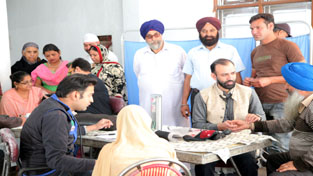
Excelsior Correspondent
JAMMU, Mar 20: Although the coronary artery disease (CAD) rates are lower in rural than urban India, the overall CAD burden is higher in rural India. This is because far more Indians live in rural areas, where access to health care is limited
This was stated by Head, Department of Cardiology in Government Medical College and Superspeciality Hospital (GMC&SSH) Dr. Sushil Sharma during a daylong camp held at Tali Morh Gurudwara in Simbal Camp.
He said that although two thirds of India’s 1.2 billion population lives in rural areas, the greater interconnectedness increasingly allows rural populations to adopt urban lifestyles without migration to urban areas. CAD rates are also increasing in rural areas as lifestyles become more westernized, added Dr. Sushil. He said that despite a higher rate of tobacco use, the heart disease and diabetes rates are approximately half in rural than in urban India.
Nonetheless, the prevalence of cardiovascular disease (CVD) in rural areas was also increasing rapidly and emerging as a major cause of death, said Dr. Sushil while adding that although CVD prevalence is likely to remain lower in rural areas relative to urban areas, it is projected to increase considerably over the next few years, reaching a high of 14% among the rural elderly (60-69 year olds).
Contemporary data showed a high age-standardized prevalence of modifiable risk factors in rural India which indicated that the epidemic of CAD would soon expand to rural India.
However, Dr. Sushil said that 18%-21% were underweight and thus under-nutrition and over-nutrition coexist in rural Jammu and Kashmir. He maintained that higher prevalence of many risk factors (obesity, dyslipidemia, and diabetes and high blood pressure) is common in those in the high socioeconomic group in rural India. For example, 35% of women in the highest socioeconomic group were obese compared with 13% in the lowest.
The team of doctors which assisted Dr. Sushil included Dr. Mohi Kalsotra, Dr. Dhaneshwar Kapoor, Dr. Anchit Singh and Dr. Anitipal Singh. Paramedics and Volunteers who were part of the team included Kashmiri Lal, Kamal Kishore, Sanjay Sharma, Gaurav Sharma, Raj Kumar, Mohan Krishan and Aman Gupta.

